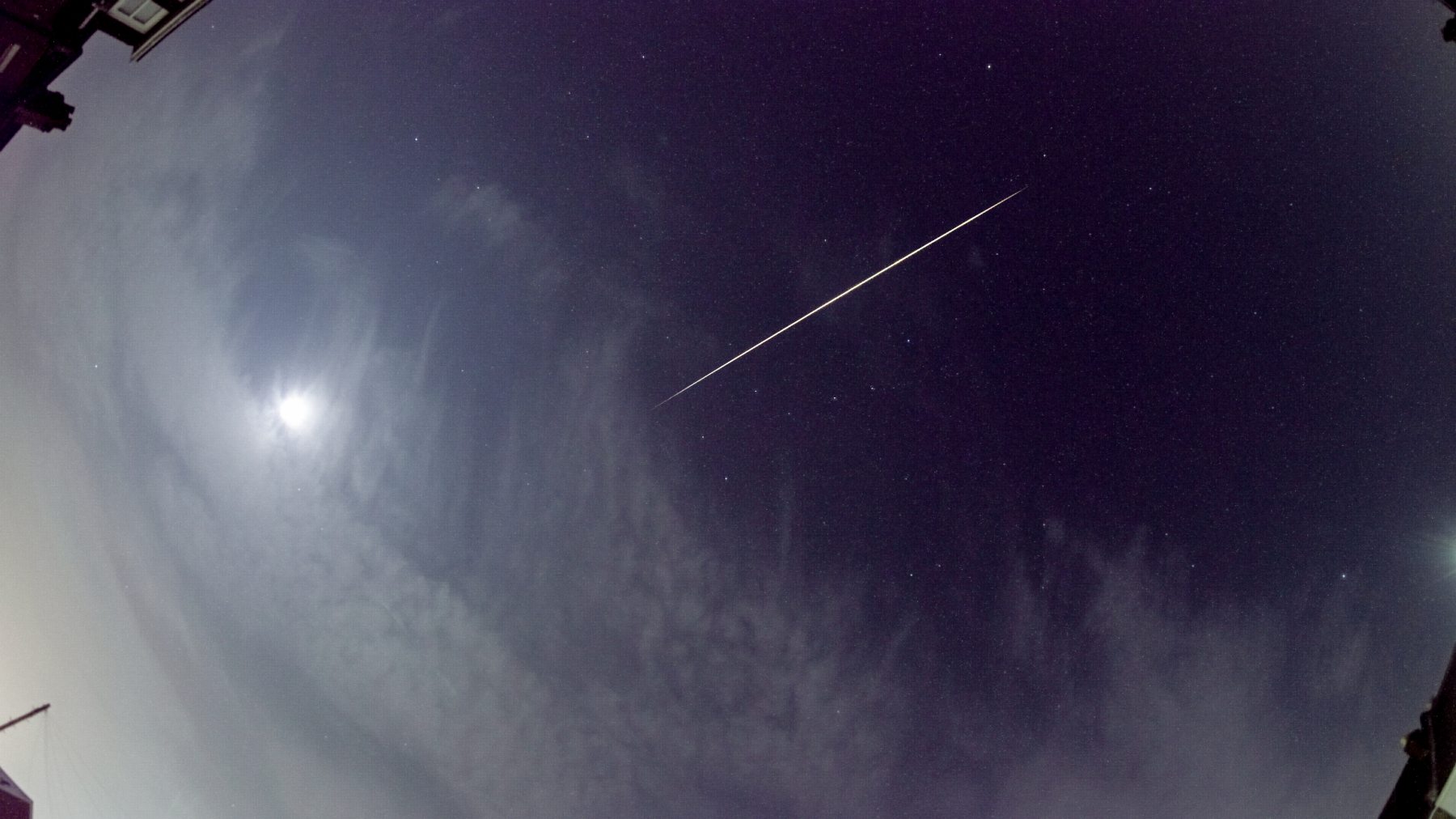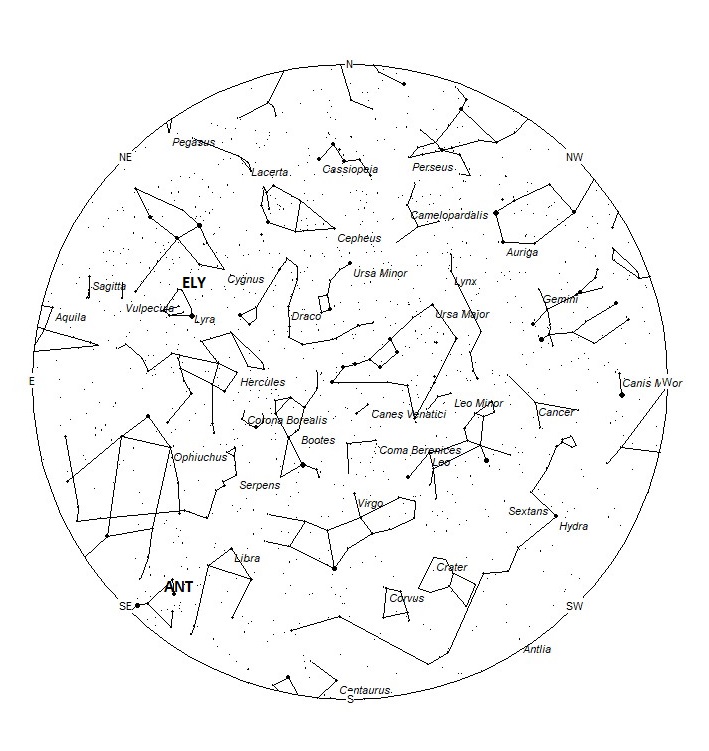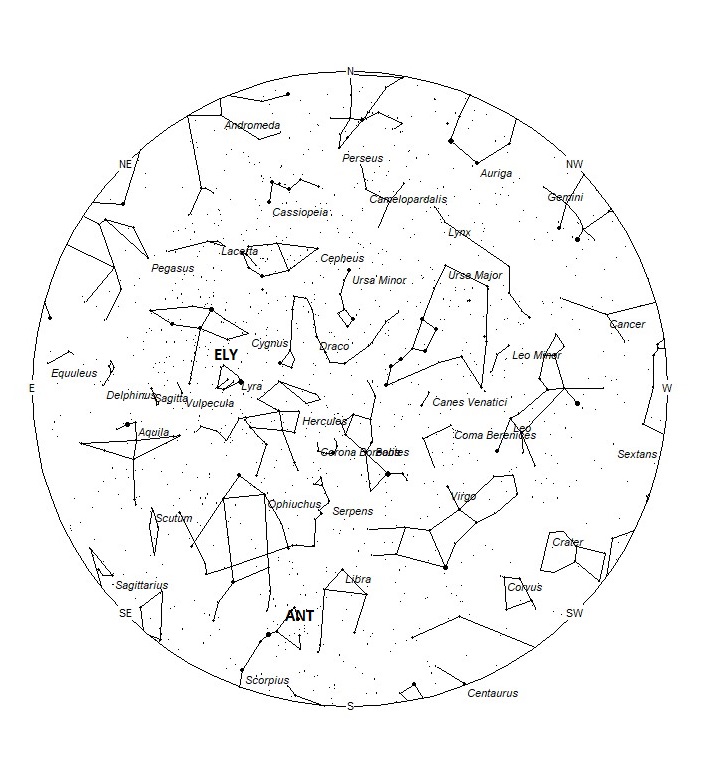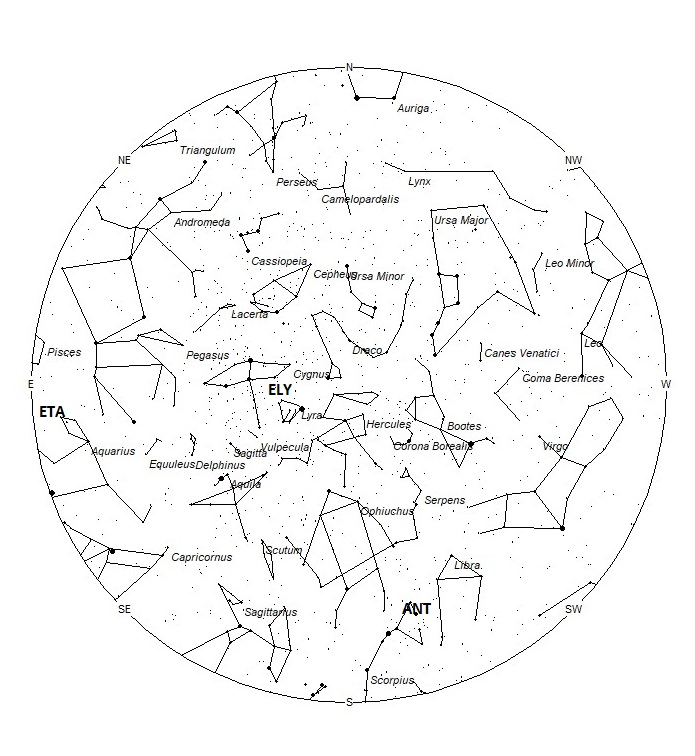 David Alger used a Sony A7sII 4K video camera and a Samyang 12mm f2.8 lens to capture this fireball on 23 March 2021, from Portsmouth, England, GB. Notice that is passes just above the stars of the “Big Dipper or Plough” (Ursa Major) . ©David Alger
David Alger used a Sony A7sII 4K video camera and a Samyang 12mm f2.8 lens to capture this fireball on 23 March 2021, from Portsmouth, England, GB. Notice that is passes just above the stars of the “Big Dipper or Plough” (Ursa Major) . ©David AlgerDuring this period the moon reaches its new phase on Tuesday May 11th. On this date the moon is located near the sun and is invisible at night. This weekend the waning crescent moon will rise during the early morning hours but will not interfere with meteor observing as it will be too thin and only in the sky an hour or two prior to sunrise. The estimated total hourly meteor rates for evening observers this week is near 3 as seen from mid-northern latitudes (45N) and 4 as seen from tropical southern locations (25S). For morning observers, the estimated total hourly rates should be near 11 as seen from mid-northern latitudes (45N) and 23 as seen from tropical southern locations (25S). The actual rates will also depend on factors such as personal light and motion perception, local weather conditions, alertness, and experience in watching meteor activity. Note that the hourly rates listed below are estimates as viewed from dark sky sites away from urban light sources. Observers viewing from urban areas will see less activity as only the brighter meteors will be visible from such locations.
The radiant (the area of the sky where meteors appear to shoot from) positions and rates listed below are exact for Saturday night/Sunday morning May 8/9. These positions do not change greatly day to day so the listed coordinates may be used during this entire period. Most star atlases (available at science stores and planetariums) will provide maps with grid lines of the celestial coordinates so that you may find out exactly where these positions are located in the sky. A planisphere or computer planetarium program is also useful in showing the sky at any time of night on any date of the year. Activity from each radiant is best seen when it is positioned highest in the sky, either due north or south along the meridian, depending on your latitude. It must be remembered that meteor activity is rarely seen at the radiant position. Rather they shoot outwards from the radiant, so it is best to center your field of view so that the radiant lies at the edge and not the center. Viewing there will allow you to easily trace the path of each meteor back to the radiant (if it is a shower member) or in another direction if it is sporadic. Meteor activity is not seen from radiants that are located far below the horizon. The positions below are listed in a west to east manner in order of right ascension (celestial longitude). The positions listed first are located further west therefore are accessible earlier in the night while those listed further down the list rise later in the night.
These sources of meteoric activity are expected to be active this week.
.
The center of the large Anthelion (ANT) radiant is currently located at 16:04 (241) -21. This position lies in northwestern Scorpius, only 1 degree southwest of the 3rd magnitude double star known as Acrab (beta Scorpii Aa). Due to the large size of this radiant, Anthelion activity may also appear from northwestern Scorpius as well as Libra. This radiant is best placed near 0200 local summer time (LST) , when it lies on the meridian and is located highest in the sky. Rates at this time should be near 1 per hour as seen from the Northern Hemisphere and 2 per hour as seen from south of the equator. With an entry velocity of 30 km/sec., the average Anthelion meteor would be of slow velocity.
The eta Lyrids (ELY) are active from May 3-14 with maximum activity occurring on the 8th. The radiant is currently located at 19:21 (290) +43. This area of the sky is located in northeastern Lyra, 3 degrees northeast of the 4th magnitude star known as eta Lyrae. The radiant is also located 8 degrees northeast of the brilliant zero magnitude star known as Vega (alpha Lyrae). This radiant is best placed during the last hour before dawn when it lies highest above the horizon in a dark sky. Current rates are expected near 1 per hour as seen from the Northern Hemisphere and less than 1 and seen from south of the equator. These meteors are not well seen from locations south of the equator as the radiant does not rise very high into the northern sky. With an entry velocity of 45 km/sec., the average meteor from this source would be of medium velocity.
The eta Aquariids (ETA) are still active from a radiant located at 22:38 (340) 00. This area of the sky is located in northeastern Aquarius, 1 degree east of the 4th magnitude star known as eta Aquarii. These meteors are not visible prior to 0100 LST and are best seen just before the start of dawn when the radiant lies highest in a dark sky. Current hourly are expected to range from 10 as seen from the southern tropics to near zero as seen from high northern latitudes. With an entry velocity of 66 km/sec., the average meteor from this source would be of swift velocity.
As seen from the mid-northern hemisphere (45N) one would expect to see approximately 5 sporadic meteors per hour during the last hour before dawn as seen from rural observing sites. Evening rates would be near 2 per hour. As seen from the tropical southern latitudes (25S), morning rates would be near 9 per hour as seen from rural observing sites and 3 per hour during the evening hours. Locations between these two extremes would see activity between the listed figures.
The list below offers the information from above in tabular form. Rates and positions are exact for Saturday night/Sunday morning except where noted in the shower descriptions.
| SHOWER | DATE OF MAXIMUM ACTIVITY | CELESTIAL POSITION | ENTRY VELOCITY | CULMINATION | HOURLY RATE | CLASS |
| RA (RA in Deg.) DEC | Km/Sec | Local Summer Time | North-South | |||
| Anthelion (ANT) | – | 16:04 (241) -21 | 30 | 02:00 | 2 – 3 | II |
| eta Lyrids (ELY) | May 08 | 19:21 (290) +43 | 45 | 05:00 | 1 – <1 | II |
| eta Aquariids (ETA) | May 05 | 22:38 (340) 00 | 66 | 09:00 | 3 – 10 | I |







 You saw something bright and fast? Like a huge shooting star? Report it: it may be a fireball.
You saw something bright and fast? Like a huge shooting star? Report it: it may be a fireball.  You counted meteors last night? Share your results with us!
You counted meteors last night? Share your results with us!  You took a photo of a meteor or fireball? You have a screenshot of your cam? Share it with us!
You took a photo of a meteor or fireball? You have a screenshot of your cam? Share it with us!  You caught a meteor or fireball on video? Share your video with us!
You caught a meteor or fireball on video? Share your video with us!